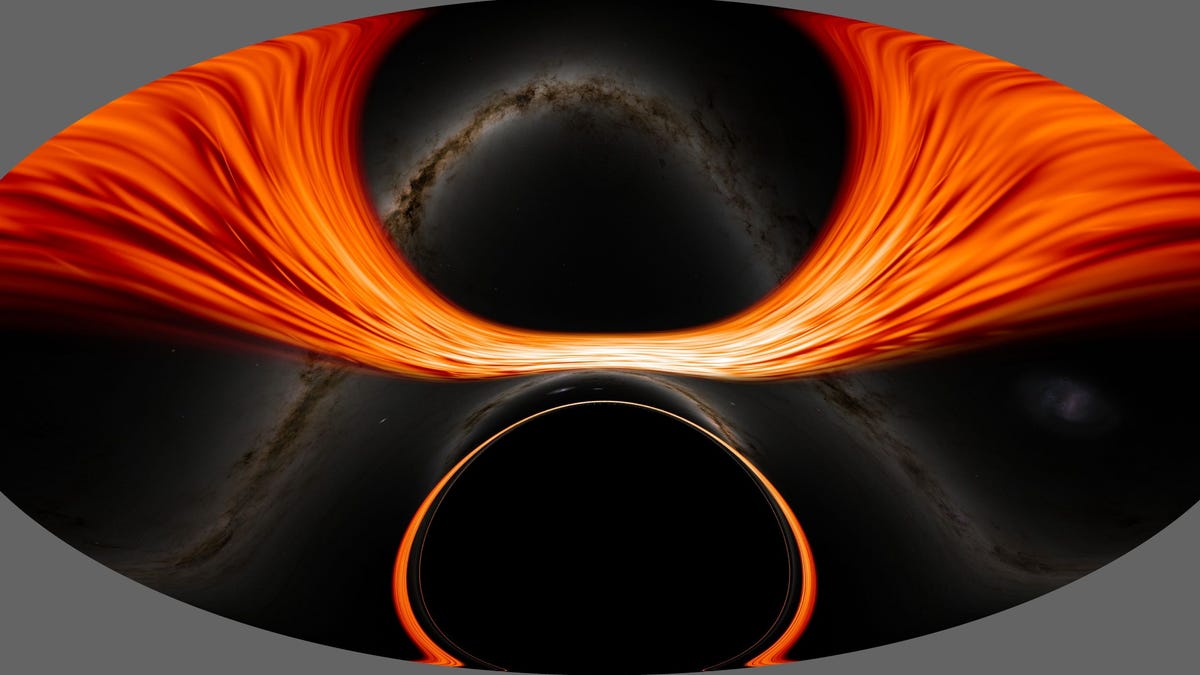
The four visuals available on YouTube include captions to guide viewers on what they’re watching and include 360-degree versions to allow viewers to look around during the virtual ride.
Have you ever wondered what happens when you fall into a black hole?
A supercomputer at NASA has produced an immersive simulation of what happens when an object falls into a supermassive black hole.
Anyone who watched Matthew McConaughey dive into a massive black hole “Interstellar” They may think they have a rough idea of what it would be like to encounter one of these terrifying cosmic formations.
But a Hollywood blockbuster set decades in the future can’t compare to the real thing, even if it’s directed by Christopher Nolan. Ten years after Interstellar hit theaters, NASA is now giving us a more personal experience of what would happen if we fell into a black hole.
No, even the most intrepid astronauts have not yet been able to get anywhere near these massive creatures, where the gravitational pull is so intense that even light does not have enough energy to escape their grasp.
in the meantime, The simulation was released on Monday Instead, simply imagine what a person would see as they descend toward the black hole’s event horizon to their inevitable death. Another simulation released by NASA shows an imagined view of an astronaut flying through a black hole as space appears to bend and shift.
“I simulated two different scenarios, one where the camera—taking the place of a daring astronaut—misses the event horizon and the slingshot comes back out, and one where it crosses the border, sealing its fate,” said astrophysicist Jeremy Schnittman. in NASA Goddard Space Flight Center in Greenbelt, Maryland who produced the visualizations.
Horsehead Nebula: New images captured by NASA’s Webb Telescope show a distinctive “mane” in stunning detail
NASA simulation shows sinking into a black hole
While humanity has learned a lot about black holes in recent years since the first black hole appeared It was identified in 1964Things remain remarkably ambiguous.
New NASA visualizations are available at Goddard’s YouTube pageClear some of this puzzle. The visuals are divided into one-minute rides presented as 360-degree videos that allow viewers to look around during the ride, and extended versions with… Explanations To direct viewers to what they are witnessing.
The simulation’s destination is a hypothetical supermassive black hole with a mass 4.3 million times the mass of Earth’s Sun, which is about the size of the monster Sagittarius A* at the center of our Milky Way Galaxy.
First simulation It shows the viewer approaching the black hole from about 400 million miles away and rapidly descending toward the event horizon — a theoretical limit known as the “point of no return” where light and other radiation can no longer escape. Like Sagittarius A*, the simulation’s event horizon extends about 16 million miles.
Cloud structures called photon rings and a flat, rotating cloud of hot, glowing gas called an accretion disk surrounding the black hole serve as a visual reference during the fall. When the camera reaches the speed of light, the accretion disk becomes more distorted as spacetime warps.
Once inside the black hole itself, the viewer is thrust into the center of the one-dimensional black hole, which is called A UniquenessWhere the laws of physics as we know them cease to exist.
Simulations were performed using the Discover supercomputer in NASA Climate Simulation Centerand produced about 10 terabytes of data, which represents about half of the estimated text content in Library of Congress.
The second simulation shows the viewer narrowly escaping the black hole
Astronomers divide black holes into: Three general categories On the basis of mass: stellar mass, supermass, and intermediate mass.
Schnittman explained that stellar-mass black holes, which form when a star more than eight times the mass of the Sun runs out of fuel and its core explodes in a supernova, are less ideal for falling into than their super-massive counterparts.
“If you had the choice, you would want to fall into a massive black hole,” Schnittman said in a statement. “Stellar-mass black holes, which have up to about 30 solar masses, have much smaller event horizons and stronger tidal forces, which can tear apart approaching objects before they reach the horizon.”
This happens because the gravitational force on one end of an object closer to the black hole is much stronger than the gravitational force on the other end. Falling objects expand like spaghetti, a process astrophysicists call… macaroni. For this simulated black hole, it would take the viewer only about 12.8 seconds to achieve its end via spaghetti.
Alternative simulation It shows an observer orbiting near the event horizon but escaping to safety before crossing it.
If an astronaut flew a spacecraft on this 6-hour round trip, the explorer would return 36 minutes younger than those who remained on the mothership far away. NASA explained. This is another concept that will be familiar to Interstellar fans, due to time passing more slowly near a strong gravitational source.
“This situation could be more extreme,” Schnittman said. “If the black hole was rotating rapidly, like the one shown in the 2014 movie Interstellar, (the astronaut) would come back many years younger than her shipmates.”
Eric Lagata covers breaking and trending news for USA TODAY. Contact him at [email protected]




More Stories
Boeing May Not Be Able to Operate Starliner Before Space Station Is Destroyed
Prehistoric sea cow eaten by crocodile and shark, fossils say
UNC student to become youngest woman to cross space on Blue Origin